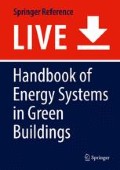Abstract
This chapter presents an introduction of an integrated energy system in a green building based upon the research experience in a green energy lab (GEL) of Shanghai Jiao Tong University. As a comprehensive platform for investigating state of the art technology in green buildings, GEL is equipped with advanced HVAC systems, renewable energy power systems, smart control systems, etc. The study on high-efficient air-conditioning system attaches great focus on green buildings as this system accounts for most of the energy consumption in a building. A case study of an integrated renewable air-conditioning system in GEL is conducted, including the high-performance heat pumps (water source and ground source) and the solar-assisted air-conditioning system. In addition, renewable energy source is another focus for the sustainable design of green buildings. A 6.72 kWp solar photovoltaic arrays and a 5 kWp wind turbine are installed in GEL as the renewable energy power system. In order to have a stable power supply, a micro-smart grid is formed by connecting the renewable energy power system with the national grid. Moreover, a home energy management system (HEMS) for a smart control and management of the energy system is included. Both the design and performance of the integrated energy systems are summarized, which is instructive for the design and operation of green buildings in Shanghai and other areas with similar geographic or climate conditions.
References
Aste N, Adhikari RS, Del Pero C (2011) Photovoltaic technology for renewable electricity production: towards net zero energy buildings//Clean Electrical Power (ICCEP), International Conference on. IEEE, 2011, pp 446–450
Alderson H, Cranston GR, Hammond GP (2012) Carbon and environmental footprinting of low carbon UK electricity futures to 2050. Energy 48(1):96–107
Omer AM (2008) Green energies and the environment. Renew Sust Energ Rev 12(7):1789–1821
Kibert CJ (2016) Sustainable construction: green building design and delivery. Wiley, New Jersey
Qin X, Mo Y, Jing L (2016) Risk perceptions of the life-cycle of green buildings in China. J Clean Prod 126:148–158
Ministry of Housing and Urban–Rural Development of the People’s Republic of China (MOHURD) (2006) General administration of quality supervision, inspection and quarantine of the People’s Republic of China (AQSIQ), evaluation standard for green building, in: GB/T50378–2006. China Architecture & Building Press, Beijing
MOHURD (2013) Report about building energy efficiency in special supervision on energy saving and emission reduction of National Housing Urban and Rural Construction Field in 2012. http://www.mohurd.gov.cn/
Liu Y, Guo X, Hu F (2014) Cost-benefit analysis on green building energy efficiency technology application: a case in China. Energ Buildings 82:37–46
USGBC Building design leaders collaborating on carbon-neutral buildings by 2030. Available at: www.usgbc.org/News/PressReleaseDetails.aspx?ID=3124
Yudelson J (2010) The green building revolution. Island Press, Washington, DC
Kong XQ, Wang RZ, Wu JY et al (2005) Experimental investigation of a micro-combined cooling, heating and power system driven by a gas engine. Int J Refrig 28(7):977–987
Hashim H, Ho WS (2011) Renewable energy policies and initiatives for a sustainable energy future in Malaysia. Renew Sust Energ Rev 15(9):4780–4787
Ye L, Cheng Z, Wang Q et al (2013) Overview on green building label in China. Renew Energy 53:220–229
Zhai XQ, Wang RZ (2009) Experimental investigation and theoretical analysis of the solar adsorption cooling system in a green building. Appl Therm Eng 29(1):17–27
Zhai XQ, Wang XL, Pei HT et al (2012) Experimental investigation and optimization of a ground source heat pump system under different indoor set temperatures. Appl Therm Eng 48:105–116
Wang DC, Xia ZZ, Wu JY et al (2005) Study of a novel silica gel–water adsorption chiller. Part I. Design and performance prediction. Int J Refrig 28(7):1073–1083
Zhai XQ, Wang RZ, Dai YJ et al (2007) Solar integrated energy system for a green building. Energ Buildings 39(8):985–993
Wang RZ, Zhai XQ (2013) Energy systems in green buildings. Shanghai Jiao Tong University Press (in Chinese), Shanghai
Pei HT, Zhai XQ, Wang QJ (2013) Experimental study on a small vertical borehole ground-coupled heat pump system. Building Sci (in Chinese) 29(2):66–69
Yu X, Wang RZ, Zhai XQ (2011) Year round experimental study on a constant temperature and humidity air-conditioning system driven by ground source heat pump. Energy 36(2):1309–1318
Denkenberger D, Parisi M, Pearce JM (2014) Towards low-cost microchannel heat exchangers: vehicle heat recovery ventilator prototype. In: International conference on heat transfer, fluid mechanics and thermodynamics
Deng S, Ruzhu W, Yanjun D (2012) Case study of Net Zero Energy Apartment in Shanghai, International High Performance Buildings Conference. p 94. http://docs.lib.purdue.edu/ihpbc/94
US Enviromental Protection Agency (2016) Green building. http://www.epa.gov/greenbuilding/pubs/about.htm. Accessed 16 Dec 2016
Deng S, Dai YJ, Wang RZ et al (2011) Case study of green energy system design for a multi-function building in campus. Sustainable Cities and Society 1(3): 152–163.
Author information
Authors and Affiliations
Corresponding author
Editor information
Editors and Affiliations
Section Editor information
Rights and permissions
Copyright information
© 2017 Springer-Verlag GmbH Germany
About this entry
Cite this entry
Cheng, X. (2017). Integrated Energy System in a Green Energy Lab. In: Wang, R., Zhai, X. (eds) Handbook of Energy Systems in Green Buildings. Springer, Berlin, Heidelberg. https://doi.org/10.1007/978-3-662-49088-4_9-1
Download citation
DOI: https://doi.org/10.1007/978-3-662-49088-4_9-1
Received:
Accepted:
Published:
Publisher Name: Springer, Berlin, Heidelberg
Print ISBN: 978-3-662-49088-4
Online ISBN: 978-3-662-49088-4
eBook Packages: Springer Reference EnergyReference Module Computer Science and Engineering

